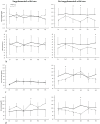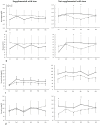Influence of Genetic Polymorphisms and Biochemical Biomarkers on Response to Nutritional Iron Supplementation and Performance in a Professional Football Team: A Pilot Longitudinal Study
- PMID: 40284242
- PMCID: PMC12030593
- DOI: 10.3390/nu17081379
Influence of Genetic Polymorphisms and Biochemical Biomarkers on Response to Nutritional Iron Supplementation and Performance in a Professional Football Team: A Pilot Longitudinal Study
Abstract
Background: Iron deficiency is a prevalent issue among elite athletes, particularly in endurance-based sports like football, where optimal iron status is crucial for aerobic capacity and performance. Despite the well-documented role of iron in oxygen transport and energy metabolism, the interplay between genetic polymorphisms, biochemical markers, and iron supplementation remains poorly understood. This study aimed to investigate the relationship between genetic polymorphisms and iron status in professional football players, assess the impact of iron supplementation on athletic performance, and develop a predictive model for iron supplementation based on genetic and biochemical profiles.
Methods: A longitudinal study was conducted over three seasons (2021-2024) with 48 male professional football players. Participants underwent genotyping for polymorphisms in ACE (rs4646994), ACTN3 (rs1815739), AMPD1 (rs17602729), CKM (rs8111989), HFE (rs1799945), and MLCK (rs2700352, rs28497577). Biochemical markers (ferritin, haemoglobin, haematocrit, serum iron) and performance metrics (GPS-derived data) were monitored. Iron supplementation (105 mg/day ferrous sulphate) was administered to players with ferritin <30 ng/mL. A Total Genotype Score (TGS) was calculated to evaluate genetic predisposition.
Results: Players with "optimal" genotypes (ACE DD, ACTN3 CC, AMPD1 CC, HFE GC) required less iron supplementation (TGS = 51.25 vs. 41.32 a.u.; p = 0.013) and exhibited better performance metrics. Iron supplementation significantly improved haemoglobin and haematocrit in deficient players (p < 0.05). The TGS predicted supplementation need (AUC = 0.711; p = 0.023), with a threshold of 46.42 a.u. (OR = 5.23, 95% CI: 1.336-14.362; p = 0.017 for non-supplemented players). Furthermore, performance data revealed that iron-supplemented players had significantly lower competition time (1128.40 vs. 1972.84 min; p = 0.003), total distance covered (128,129.42 vs. 218,556.64 m; p = 0.005), and high-speed running in the 18-21 km/h (7.58 vs. 10.36 m/min; p = 0.007) and 21-24 km/h (4.43 vs. 6.13 m/min; p = 0.010) speed zones. They also started fewer matches (11.50 vs. 21.59; p < 0.001).
Conclusions: Genetic profile combined with biochemical monitoring effectively predicts iron supplementation needs in athletes. Personalized nutrition strategies, guided by TGS, can optimize iron status and enhance performance in elite football players. This approach bridges a critical gap in sports science, offering a framework for precision nutrition in athletics.
Keywords: football; genetic profile; iron supplementation; performance; personalized nutrition.
Conflict of interest statement
The author declares no conflicts of interest.
Figures





Similar articles
-
Association of Genetic Profile with Muscle Mass Gain and Muscle Injury Prevention in Professional Football Players after Creatine Supplementation.Nutrients. 2024 Aug 1;16(15):2511. doi: 10.3390/nu16152511. Nutrients. 2024. PMID: 39125391 Free PMC article.
-
Association of iron supplementation, HFE and AMPD1 polymorphisms and biochemical iron metabolism parameters in the performance of a men's World Tour cycling team: A pilot study.J Trace Elem Med Biol. 2024 Jul;84:127470. doi: 10.1016/j.jtemb.2024.127470. Epub 2024 May 11. J Trace Elem Med Biol. 2024. PMID: 38744035
-
Association between ACE and ACTN3 genes polymorphisms and athletic performance in elite and sub-elite Chinese youth male football players.PeerJ. 2023 Mar 24;11:e14893. doi: 10.7717/peerj.14893. eCollection 2023. PeerJ. 2023. PMID: 36992938 Free PMC article.
-
Genes for elite power and sprint performance: ACTN3 leads the way.Sports Med. 2013 Sep;43(9):803-17. doi: 10.1007/s40279-013-0059-4. Sports Med. 2013. PMID: 23681449 Review.
-
The association of the ACTN3 R577X and ACE I/D polymorphisms with athlete status in football: a systematic review and meta-analysis.J Sports Sci. 2021 Jan;39(2):200-211. doi: 10.1080/02640414.2020.1812195. Epub 2020 Aug 28. J Sports Sci. 2021. PMID: 32856541
Cited by
-
Precision nutrition in sports science: an opinion on omics-based personalization and athletic outcomes.Front Nutr. 2025 Jun 6;12:1611440. doi: 10.3389/fnut.2025.1611440. eCollection 2025. Front Nutr. 2025. PMID: 40547365 Free PMC article. No abstract available.
References
-
- Bedrač L., Deutsch L., Terzić S., Červek M., Šelb J., Ašič U., Verstraeten L.M.G., Kuščer E., Cvetko F. Towards Precision Sports Nutrition for Endurance Athletes: A Scoping Review of Application of Omics and Wearables Technologies. Nutrients. 2024;16:3943. doi: 10.3390/nu16223943. - DOI - PMC - PubMed
-
- Kuwabara A.M., Tenforde A.S., Finnoff J.T., Fredericson M. Iron Deficiency in Athletes: A Narrative Review. PM&R. 2022;14:620–642. - PubMed
MeSH terms
Substances
Grants and funding
LinkOut - more resources
Full Text Sources
Medical
Miscellaneous

